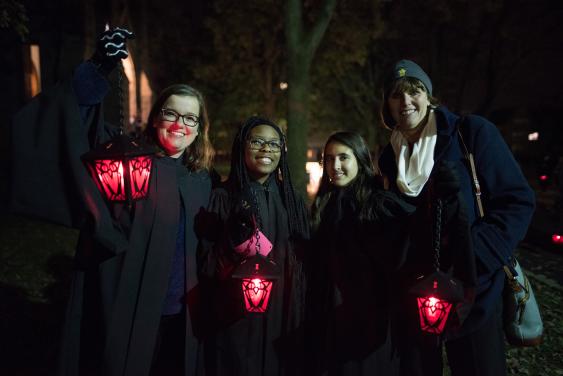By Jingsia Hathorne, Staff Writer
The moment I stepped outside into the cloisters at Old Library with an abundance of other individuals wearing black robes and listening to the Greek hymn Pallas Athena thea, it struck me: “Shit, I’m joining a cult.” Regardless, the sky that night was black and clear, and the bright, iridescent moon and twinkling stars put me at ease as I contemplated the beauty of Bryn Mawr. Lantern Night creates an intimacy between one another that involves Traditions Mistresses, Swingers, faculty, family members, alumni, and others to come to celebrate the “light of knowledge.”
Every fall, Mawrters from each class come together to celebrate Lantern Night, a tradition that passes the light of knowledge in the form of a lantern from the sophomore to the first-year class. Each of the lanterns, which are ordered a year in advance from a father and son who make them, is customized according to class color and is meant to be a treasure that Mawrters can keep for the rest of their lives.
The history behind Lantern Night is almost as old as the college itself. The story goes that the very first Lantern Night was held in 1886 as a result of a biology lab incident involving fireflies and lanterns. The first Lantern Night in the cloisters was in 1906. The lanterns at the time were “four inches high and made of silver.” It used to be that each class would design their lantern and “the number of holes in each lantern corresponded to the class year.”
The peculiarity of Bryn Mawr’s traditions creates a unique and inclusive environment that makes the campus “feel so at home,” as Liz Marchini, one of the two Traditions Mistresses of ‘23, said. Marchini was able to share details about the work that goes into planning for traditions, such as the number of individuals to coordinate with, making sure alumni get in contact with the right people if they want to watch Lantern Night, how carefully the advertisement needs to be displayed as to not attract non-community members, how many bouncers and ticket-checkers there will be so that nobody can sneak in, making sure that all the club invitation papers are attached to each lantern, and so on.
The job of a Traditions Mistress clearly involves a lot of hard work, especially when combined with the added stress of academic responsibilities. The rigorous effort involved with setting up Lantern Night also shows the commitment to community Mawrters have in regard to each new class that enters Bryn Mawr.
However, while the traditions at Bryn Mawr are exciting and can be seen as “indoctrination at its finest,” it’s the nurturing community that makes Bryn Mawr College its own treasure. When asked why Bryn Mawr is distinctive, Marchini responded by saying, “They support me when I need to be supported. It’s the people that make Bryn Mawr… belonging to a group that accepted me with all of my quirks… that matters.” By the end of the night, everyone was taking photos and waiting together for their light to go out before heading to bed.
The Gaelic translation of Bryn Mawr is “Big Hill,” and that’s what the college experience can sometimes feel like—but the traditions create memories and a feeling of inclusiveness that all help to make the climb more bearable. And so, by the end of the evening, it felt less like an eerie cult and more like a wholesome gathering of co-supportive students.
Image credit: Bryn Mawr College
